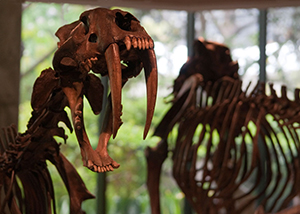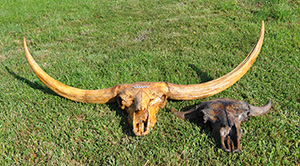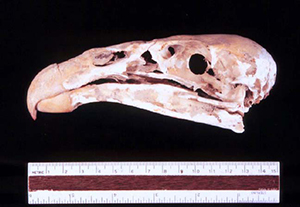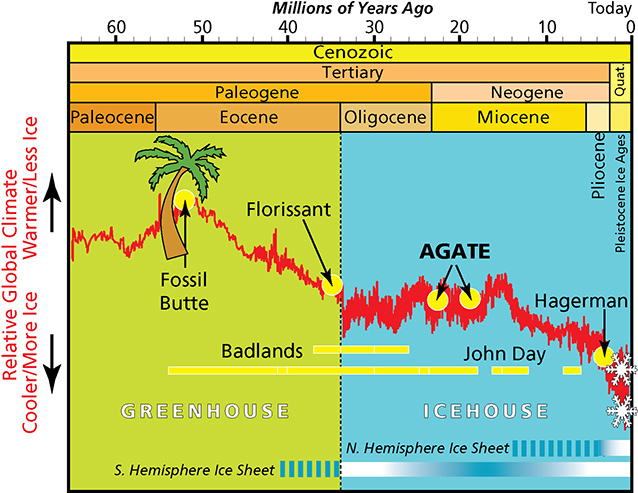Pleistocene ecosystems

The 2016 artwork features three iconic Pleistocene ("ice age") animals from the United States—saber-toothed cat, long-horned bison, and a condor flying above. The landscape is an idealized representation of southern Nevada within what is now Tule Springs Fossil Beds National Monument.
Starting in February 2016, the National Fossil Day website will feature a different Pleistocene Partner each month. These partners preserve fossils and their stories from the Pleistocene Epoch, the slice of geologic time spanning from 2.58 million (2,580,000) to 11,700 years ago. Scroll down to learn more about the featured animals, the Pleistocene, and places to see Pleistocene fossils. Check the National Fossil Day website each month for a new feature article! This year marks the second appearance of Pleistocene fossils on National Fossil Day artwork. A mammoth appeared on the 2012 artwork.
Saber-toothed cat: Dining al dente

La Brea Tar Pits & Museum photo.
The saber-toothed cat Smilodon fatalis is a well known fossil but just one of many predatory cats of the Pleistocene in North America as lions, cougars, jaguars, lynx, and cheetah also lived here. You would be hard pressed to find a fossil feature that says "I'm a predator!" more than the massive canines of Smilodon. The namesake teeth were about 7 inches long. The entire animal was more than 3 feet tall and weighed between 350 and 600 or more pounds. Smilodon fatalis is best known from the La Brea Tar Pits near Los Angeles and saber-toothed cat is the state fossil of California. Saber teeth have a rich fossil record going back tens of millions of years in cat-like animals such as nimravids from John Day Fossil Beds National Monument in Oregon.
Word origins
Smilo comes from the Greek work for knife or chisel and odon is a Greek term referring to teeth.
Fatalis was derived from the Latin word for "of destiny." The words "fate" and "fatal" use the same word root. Many herbivores met their fate soon after meeting the teeth of Smilodon!
Bison latifrons: The original longhorn

NPS photo.
Bison emigrated into North America from Eurasia about between 200,000 and 300,000 years ago. Bison latifrons evolved in North America and was a true giant. Its namesake horns spanned more than 80 inches. It was more than 8 feet tall the shoulder and weighed as much as a pickup truck (about 4400 pounds). It was one of the largest bovids (family of hooved ruminants including bison, modern cattle, sheep and goats) to ever walk the earth. For comparison, modern North American bison (Bison bison) bulls are up to 6 feet at the shoulder and are half as heavy with horns spanning only a third of the distance of B. latifrons. The huge horns of B. latifrons were likely used for display to impress other bison or as a cause for pause by predators like Smilodon.
Word origins
Bison is a Latin and old Germanic word referring to an ox or "wisent" (the European bison).
Latifrons is derived from Latin words for breadth or width (lati) and branch, brow, or "forehead" (frons).
Condor: Soaring above them all

Photo by Steve Emslie.
The California condor Gymnogyps californianus is the largest bird of prey in North America with a wingspan of up to 9.5 feet and weighing up to 23 pounds. Its ice age ancestors (sometimes referred to as Gymnogyps amplus) were even larger. During the Pleistocene Gymnogyps birds were widespread across North America. By about 500 years ago however they were confined to California and the Southwest. Today are currently a critically endangered species. A comprehensive reintroduction program that began in the 1980s and now there are more than 400 birds, half of which live in the wild. Many of them live in and around Grand Canyon National Park in Arizona. Grand Canyon is also home to many fossil condors! Their fossil record is well known from a number of caves in the canyon and date back more than 17,000 years.
Word origins
Gymno comes from the Greek word for bare or naked (referring to the "bald" head of the condor). Gyps is the Greek word for vulture.
Californianus refers to the western range of the species.
Amplus is a Latin word for large (think "amplify") and refers to the increased size of Pleistocene condors.
The "Pl-ice-tocene"

Adapted from Zachos and others (2008).
The Pleistocene Epoch spanned from 2.58 million years ago to 11,700 years ago. After 50 million years of long-term cooling and drying, Earth's climate was cold enough to support large ice sheets on both the North and the South poles—setting the stage for the Pleistocene ice ages. There was not just one ice age but many cycles of glacial advance and retreat beginning about two million years ago. During ice ages, also called glacials, ice advances from both poles as global climate, already relatively cool, chills even more. Warmer periods between ice advances are called interglacials; during such times, the ice retreats back toward the poles. Today we are in an interglacial interval following the most recent glacial advance approximately 21,000 years ago.
The ice age ice sheets were glaciers on a completely different scale from those visible in the United States today. Rather than flowing down mountain valleys, they covered continents! Ice blanketed Canada and New England, advanced past Chicago and to southern Pennsylvania. A colder and wetter climate created relatively lush habitats in areas like the American Southwest that today are better known for their dry heat. These ice sheets were no mere icy veneer. In North America, the Laurentide (eastern) ice sheet was mostly between 3,000 ft and 10,000 ft, that's about ½ to 2 miles of ice! All the water locked up in continental ice sheets reduced sea level by 400 feet and the continental shelf surrounding North America became dry land. Because water depths in the Bering Strait between Alaska and Russia are less than 160 ft (50 m), the Bering Land Bridge was also exposed during glacial periods, facilitating migration between North America and Asia.
The fossil record of Pleistocene animals and plants is incredibly varied and is found across the United States. It includes many well known fossils from Smilodon to wooly mammoths to giant ground sloths to camels to horses. The Pleistocene also saw the emergence of a new type of predator, modern humans Homo sapiens. Those humans, in concert with continued climate changes, played a role (how much of a star they were depends on which paleontologist you ask) in the extinction of much of the world's ice age giants.
Go See Them!
Pleistocene fossils are found in most natural history museums across the country, check out our list of museum partners to get started. You can also visit Pleistocene fossil sites, including the two newest fossil parks managed by the National Park Service:
- Tule Springs Fossil Beds National Monument (Nevada, established December 2014)
- Waco Mammoth National Monument (Texas, established August 2015)
- La Brea Tar Pits and Museum (Los Angeles)
- Big Bone Lick State Historic Site (Kentucky)
- The Mammoth Site of Hot Springs (South Dakota)
- Mastodon State Historic Site (Missouri)
- Hudson-Meng Education & Research Center (Nebraska)
Learn more about National Fossil Day and the NFD Logos and Artwork on the official National Fossil Day website.
Part of a series of articles titled National Fossil Day Logo and Artwork – Prehistoric Life Illustrated.
Last updated: September 8, 2020
